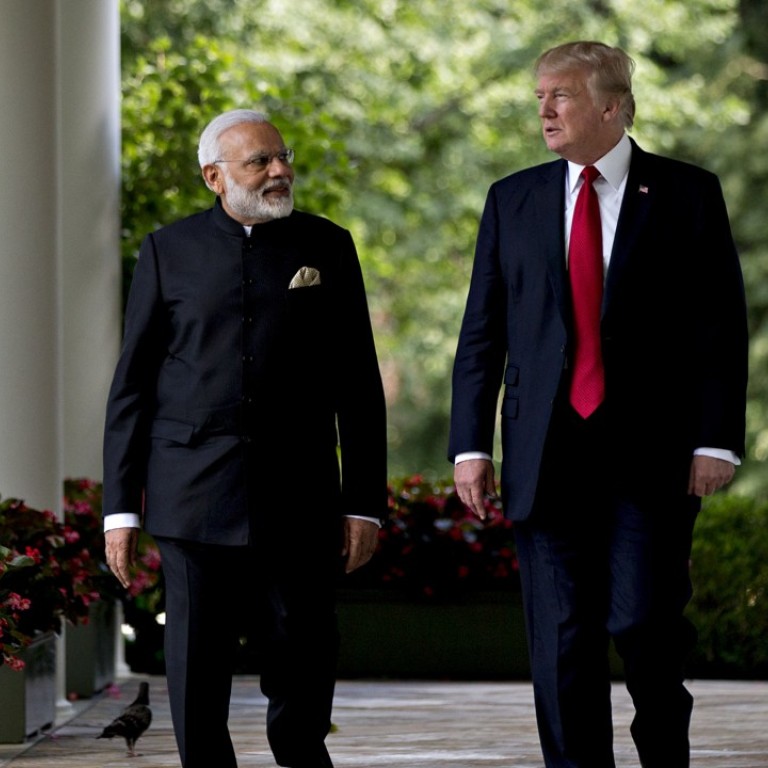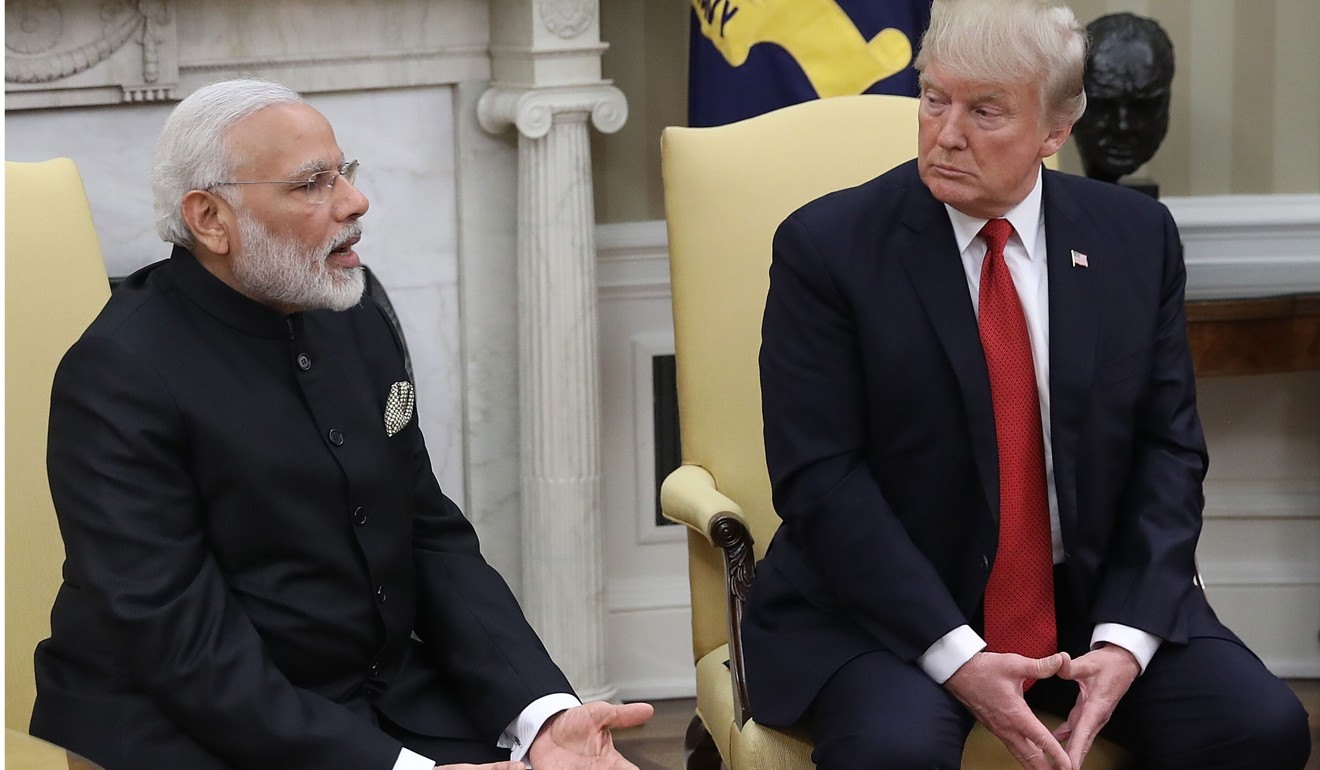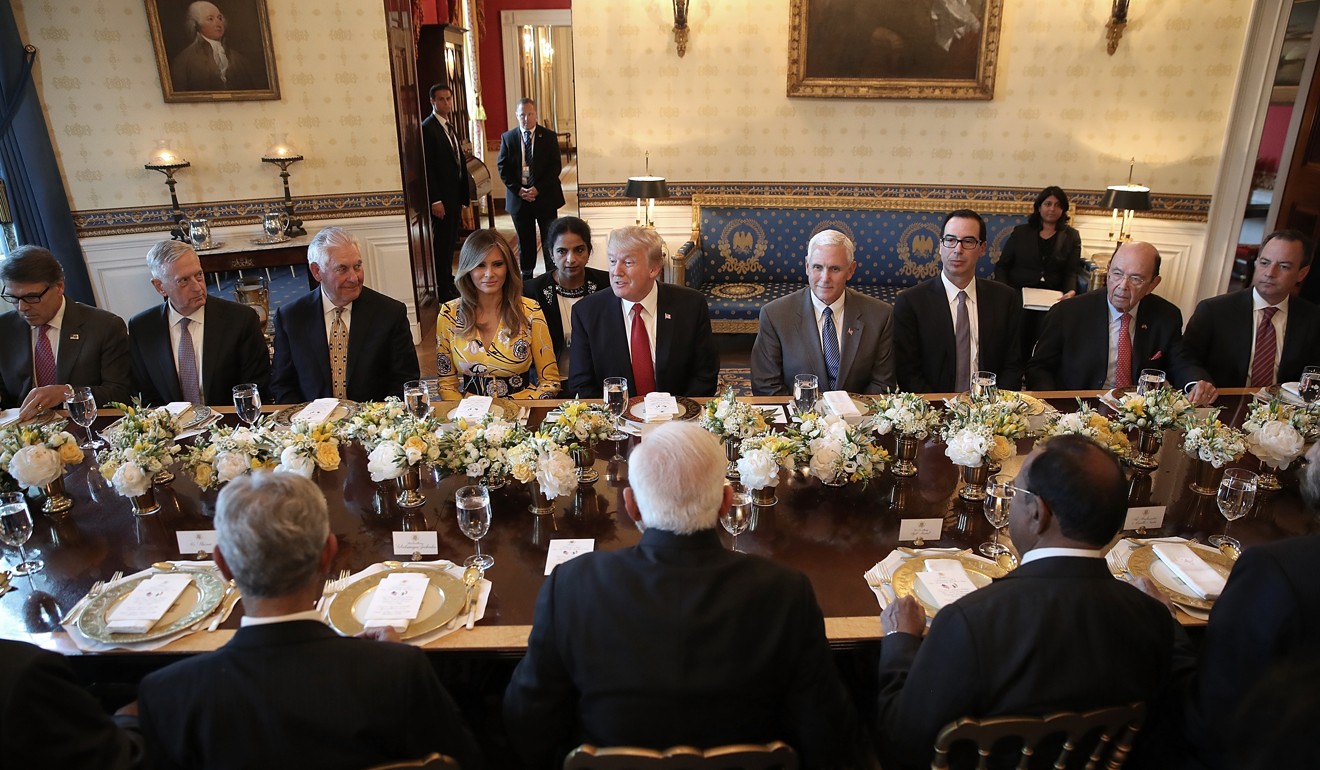
Trump-Modi meeting: India, Japan and US to hold ‘largest’ naval exercise as China extends its reach
Modi’s trip to White House relatively low key in contrast to Trump’s summit with Xi Jinping last April at his plush Florida resort
US President Donald Trump and Indian Prime Minister Narendra Modi agreed Monday to step up bilateral security partnership in the Indo-Pacific region in response to the rise of China.
Speaking at a joint news conference with Modi after their meeting at the White House, Trump said the US and Indian militaries, together with Japan’s Maritime Self-Defence Force, will hold “the largest maritime exercise ever conducted in the vast Indian Ocean” next month.
Without mentioning China’s growing naval presence in and around the Indian Ocean, Modi said maintaining peace and stability in the Indo-Pacific region is a major objective of strategic cooperation between Washington and New Delhi.
“The increasing possibilities for enhancing cooperation to protect our strategic interests will continue to determine the dimensions of our partnership,” he said through an interpreter.
“We will continue to work with the USA in this region.”
Watch: Trump welcomes Modi to the White House
Trump said the bilateral security partnership is “incredibly important.”
The Trump administration says it want to provide India with improved defence technology. The State Department on Monday approved the US$365 million sale of a C-17 military transport aircraft to India. The administration is also set to offer a US$2 billion sale of US-made unarmed drones to help in surveillance of the Indian Ocean.
Although Modi’s two-day Washington visit, which began on Sunday, is lower profile than his previous three trips to the US since he took office in 2014, it has included plenty of time spent with Trump.
Modi later joined the president and first lady for dinner – the first dinner Trump has hosted for a foreign dignitary at the White House, although he has separately hosted China’s President Xi Jinping and Japanese Prime Minister Shinzo Abe at his resort in Florida.
Any differences over issues such as immigration and climate change were kept behind closed doors and they instead vowed to work more closely on combating terrorism, the war in Afghanistan and defence cooperation.

“I would say the relationship between India and the United States has never been stronger, has never been better,” Trump told a beaming Modi as they made statements.
“I look forward to working with you, Mr prime minister, to create jobs in our countries, to grow our economies and to create a trading relationship that is fair and reciprocal.”
After Trump said it was “important that barriers be removed to the export of US goods into your markets and that we reduce our trade deficit with your country,” Modi said India was becoming an easier place for American companies to do business.
“We consider the United States as our primary partner in India’s socio-economic transformation in all our flagship programmes and schemes,” he added.

“I’m sure that convergence between my vision for a new India and President Trump’s vision for ‘Making America Great Again’ will add a new dimension to our cooperation,” added Modi, in reference to Trump’s signature campaign slogan.
Commentators had predicted that Trump and Modi would find much in common, with both men having won power by portraying themselves as establishment outsiders.
Both men are prolific users of social media, something Trump joked about with his guest.
“We’re believers, giving the people ... the opportunity to hear directly from their elected officials and for us to hear directly from them,” said Trump.
Modi in turn made Trump smile by hailing the property tycoon’s reputation as deal maker.
“I’m sure that ... your vast and successful experience in the business world will lend an aggressive and bold agenda to our relations.”

Their warm words extended into the evening, when Modi became the first foreign leader to enjoy a White House dinner since Trump came to power.
New Delhi had been alarmed by Trump’s courting of China’s president, whom he hosted at his Mar-a-Lago winter estate in April. White House officials dismissed suggestions that the administration has ignored India.
“We enjoy a wonderful relationship, but it’s never been better than it is today,” Trump told Modi at the dinner.
While ties with some allies have been strained by Trump’s complaints that Washington has been the loser in trade agreements, Modi appears sensitive to his host’s emphasis on transactional diplomacy.
India is currently the world’s fastest growing major economy, a status that Modi is hoping to cement by drawing in more foreign investment – in part by encouraging manufacturers to do business in Asia’s third-largest economy.

Ahead of his talks with Trump, Modi met with Defence Secretary James Mattis and Secretary of State Rex Tillerson.
The State Department later announced that it was slapping sanctions on a senior figure in the Kashmiri separatist group Hizb-ul-Mujahideen.
The designation of Syed Salahuddin as a global terrorist marks a diplomatic victory for India, which has been battling a decades-long insurgency by separatist groups in Kashmir, a Himalayan region divided between India and Pakistan and claimed in full by both.
US-India relations were generally cool until the 1990s, but they warmed under Trump’s predecessor Barack Obama as India sought greater foreign investment and trade ties.
Soon after Trump’s election, obstacles emerged on issues such as trade and visas for Indians wanting to work in the United States.
Trump then accused India of seeking to profit from the Paris climate accord as he announced the US withdrawal from the deal this month.

A proposed overhaul of H-1B visas – used by thousands of Indian software engineers to work in the United States – has caused concern in New Delhi.
But Indian officials have downplayed those differences, insisting that Modi was alert to Trump’s concerns over jobs and trade.
Regional security did feature in the talks, including on Afghanistan, as Washington considers deploying up to 5,000 extra troops to help local forces fighting insurgent groups.
Trump said he wanted to “thank the Indian people” for their contribution to helping development in Afghanistan.
Modi in turn said India “would maintain close consultation and communication with the US” to achieve the joint goal of “peace and stability”.
India frequently accuses its arch rival Pakistan of stirring up violence in Afghanistan and harbouring militant groups.
Kyodo, Agence France-Presse, Associated Press
